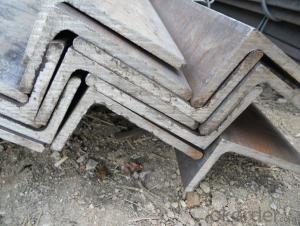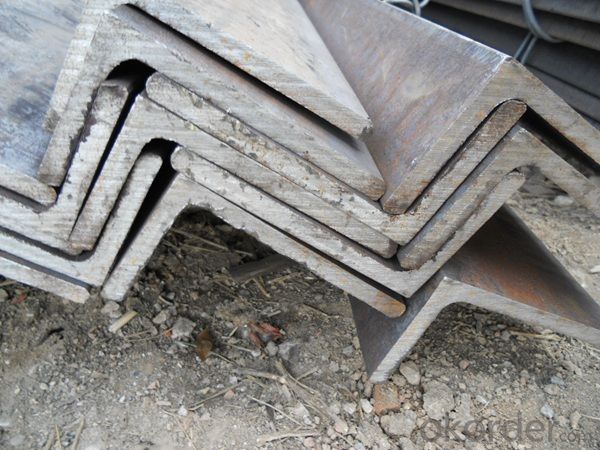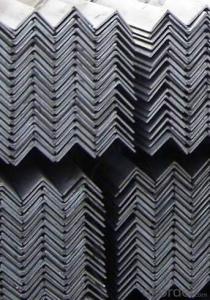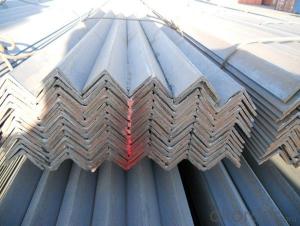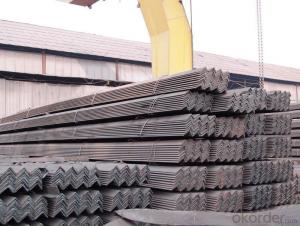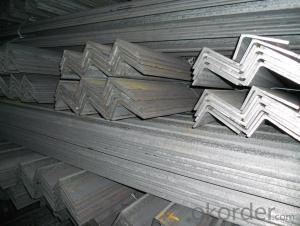Steel Unequal Angle Beams for Structure of Construction
- Loading Port:
- Tianjin
- Payment Terms:
- TT or LC
- Min Order Qty:
- 25 m.t.
- Supply Capability:
- 200000 m.t./month
OKorder Service Pledge
OKorder Financial Service
You Might Also Like
Product Description:
OKorder is offering Steel Unequal Angle Beams for Structure of Construction at great prices with worldwide shipping. Our supplier is a world-class manufacturer of steel, with our products utilized the world over. OKorder annually supplies products to African, South American and Asian markets. We provide quotations within 24 hours of receiving an inquiry and guarantee competitive prices.
Product Applications:
Steel Unequal Angle Beams for Structure of Construction are ideal for structural applications and are widely used in the construction of buildings and bridges, and the manufacturing, petrochemical, and transportation industries.
Product Advantages:
OKorder's Steel Unequal Angle Beams for Structure of Construction are durable, strong, and wide variety of sizes.
Main Product Features:
· Premium quality
· Prompt delivery & seaworthy packing (30 days after receiving deposit)
· Can be recycled and reused
· Mill test certification
· Professional Service
· Competitive pricing
Product Specifications:
Manufacture: Hot rolled
Grade: Q195 – 235
Certificates: ISO, SGS, BV, CIQ
Length: 6m – 12m, as per customer request
Packaging: Export packing, nude packing, bundled
| UNEQUAL ANGLE STEEL | |||||
| size(mm) | a(mm) | a1(mm) | thickness(mm) | kg/m | length(m) |
| 75*50*5 | 75 | 50 | 5 | 4.808 | 6m,9m,12m |
| 75*50*6 | 75 | 50 | 6 | 5.699 | 6m,9m,12m |
| 75*50*8 | 75 | 50 | 8 | 7.431 | 6m,9m,12m |
| 100*75*7 | 100 | 75 | 7 | 9.34 | 6m,9m,12m |
| 100*75*8 | 100 | 75 | 8 | 10.6 | 6m,9m,12m |
| 100*75*9 | 100 | 75 | 9 | 11.8 | 6m,9m,12m |
| 100*75*10 | 100 | 75 | 10 | 13 | 6m,9m,12m |
| 100*75*12 | 100 | 75 | 12 | 15.4 | 6m,9m,12m |
| 125*75*7 | 125 | 75 | 7 | 10.7 | 6m,9m,12m |
| 125*75*8 | 125 | 75 | 8 | 12.2 | 6m,9m,12m |
| 125*75*9 | 125 | 75 | 9 | 13.6 | 6m,9m,12m |
| 125*75*10 | 125 | 75 | 10 | 15 | 6m,9m,12m |
| 125*75*12 | 125 | 75 | 12 | 17.8 | 6m,9m,12m |
| 150*90*8 | 150 | 90 | 8 | 14.7 | 6m,9m,12m |
| 150*90*9 | 150 | 90 | 9 | 16.4 | 6m,9m,12m |
| 150*90*10 | 150 | 90 | 10 | 18.2 | 6m,9m,12m |
| 150*90*12 | 150 | 90 | 12 | 21.6 | 6m,9m,12m |
| 200*100*10 | 200 | 100 | 10 | 23 | 6m,9m,12m |
| 200*100*12 | 200 | 100 | 12 | 27.62 | 6m,9m,12m |
| 200*100*15 | 200 | 100 | 15 | 34.04 | 6m,9m,12m |
FAQ:
Q1: Why buy Materials & Equipment from OKorder.com?
A1: All products offered byOKorder.com are carefully selected from China's most reliable manufacturing enterprises. Through its ISO certifications, OKorder.com adheres to the highest standards and a commitment to supply chain safety and customer satisfaction.
Q2: How many tons of steel products could be loaded in containers?
A2: Usually the steel products are delivered by bulk vessel because of the large quantity and the freight. However, there are no bulk vessel enter some seaports so that we have to deliver the cargo by containers. The 6m steel product can be loaded in 20FT container, but the quantity is changed according to the size, usually from 18tons to 25tons.
Q3: How soon can we receive the product after purchase?
A3: Within three days of placing an order, we will arrange production. The normal sizes with the normal grade can be produced within one month. The specific shipping date is dependent upon international and government factors, the delivery to international main port about 45-60days
Images:
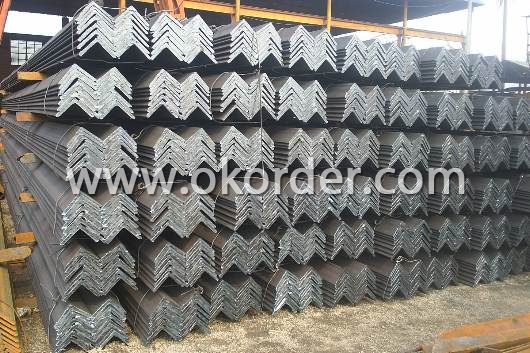
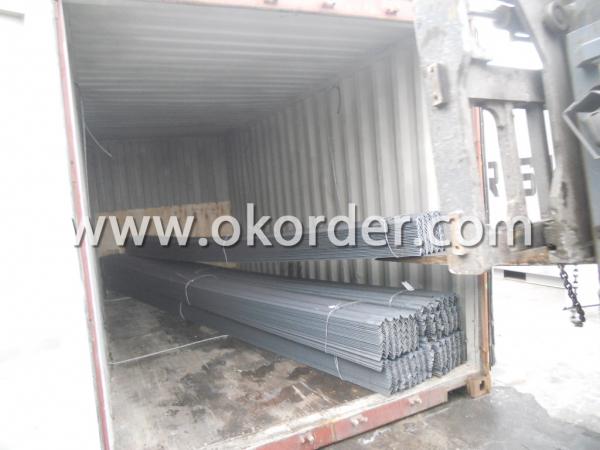
- Q: Unequal angle steel
- Unequal angle steel: in the field of engineering materials, relative to two equal side length equal angles, refers to the section of the right angle, L shaped, and unequal length of both sides of the angle. It is widely used in engineering structure, structure and variety of municipal public utilities, civil and military industries, such as industrial beams, bridges, towers, hoisting and conveying machinery, ships, industrial furnace, reaction tower, container frame, and warehouses, because the amount is less than the unilateral angle, so the relative price slightly higher.
- Q: Can steel angles be used in the construction of parking garages?
- Steel angles can indeed be utilized in the construction of parking garages. These angles are frequently employed in construction due to their robustness, durability, and versatility. They have a wide range of structural applications, including the building of parking garages. Steel angles offer support and reinforcement for crucial elements like beams and columns, as well as for framing and bracing. They play a significant role in establishing the framework for parking garage floors and walls, contributing stability and strength to the structure. Moreover, steel angles can be easily fabricated and tailored to meet the precise design and engineering specifications of a parking garage. All in all, steel angles are a favored choice for constructing parking garages because they can endure heavy loads, resist corrosion, and deliver enduring performance.
- Q: Are steel angles suitable for outdoor furniture?
- Yes, steel angles are suitable for outdoor furniture. Steel is a durable and weather-resistant material that can withstand various outdoor conditions, making it an excellent choice for outdoor furniture. Additionally, steel angles provide stability and structural support, ensuring the longevity and functionality of outdoor furniture pieces.
- Q: How to determine the neutral axis of the angle bar?
- For the bolt group, the calculation of the location of the neutral axis is more complex, and is usually approximately assumed on the bottom row of the bolt axis.
- Q: What are the advantages of using steel angles in manufacturing?
- Using steel angles in manufacturing offers several advantages. Firstly, steel angles possess immense strength and durability, making them suitable for a wide array of applications. They are capable of withstanding heavy loads and providing structural stability, making them an ideal choice for the construction of buildings, bridges, and other infrastructure projects. Secondly, steel angles provide versatility in terms of design. They can be easily customized and fabricated into different shapes and sizes, allowing manufacturers to create products that meet specific requirements. Whether it be a simple bracket or a complex framework, steel angles can be adapted to fit any desired design. Furthermore, steel angles exhibit excellent resistance to corrosion. They can endure exposure to moisture, chemicals, and other environmental factors, making them suitable for outdoor applications and industries where corrosion poses a concern. Another advantage of utilizing steel angles is their cost-effectiveness. Steel is a relatively inexpensive material compared to alternatives such as aluminum or stainless steel. Moreover, steel angles have a long lifespan, requiring minimal maintenance and replacement, thus reducing overall costs in the long term. Lastly, steel angles are readily available in the market. They can be easily obtained from steel suppliers, ensuring accessibility for manufacturers worldwide. In conclusion, the utilization of steel angles in manufacturing grants advantages in terms of strength, versatility, corrosion resistance, cost-effectiveness, and availability. These factors make steel angles the preferred choice for various industries, enabling them to produce high-quality, durable, and cost-efficient products.
- Q: Can steel angles be used in the construction of government buildings?
- Yes, steel angles can be used in the construction of government buildings. Steel angles are commonly used in construction due to their strength, durability, and versatility. They are often used for structural support, framing, and reinforcement in various building projects, including government buildings.
- Q: How do you specify steel angles in drawings?
- In order to specify steel angles in drawings, several key parameters need to be specified. Firstly, the angle size needs to be clearly indicated, usually by providing the leg lengths or the dimensions of the equal sides. For example, a 3" x 3" x 1/4" angle would have legs measuring 3 inches each and a thickness of 1/4 inch. Next, the type of angle needs to be indicated, such as L-shaped or unequal angles. This information is important as it helps determine the appropriate steel angle to be used for a specific application. Additionally, the material grade of the steel angle should be specified. Steel angles are available in various grades, which determine the strength and durability of the angle. Common grades include A36, A572, and A588, among others. The grade is typically specified to ensure the angle meets the required structural or mechanical properties. The length of the steel angle is another important parameter that needs to be stated in the drawing. Whether it is a fixed length or a specific range, this information enables accurate fabrication and installation. Finally, any additional requirements or specifications, such as surface finish, tolerance, or any specific treatments or coatings, should also be clearly indicated in the drawing to ensure the steel angle is manufactured and installed according to the desired specifications. By providing these parameters in the drawings, engineers, fabricators, and contractors can easily identify and accurately procure the required steel angles for construction or manufacturing purposes.
- Q: Are there any industry standards or codes for steel angles?
- Yes, there are industry standards and codes for steel angles. The American Society for Testing and Materials (ASTM) has established standards such as ASTM A36/A36M and ASTM A529/A529M that outline the specifications for steel angles, including dimensions, tolerances, and mechanical properties. Additionally, various building codes, such as the International Building Code (IBC), may also provide guidelines for the use of steel angles in construction projects.
- Q: How are steel angles measured and specified?
- Steel angles are typically measured and specified based on their dimensions and structural characteristics. The dimensions of a steel angle are determined by the length of its legs and the thickness of its material. The length of the legs refers to the vertical and horizontal sides of the angle, while the thickness represents the width of the angle. The dimensions of a steel angle are commonly expressed in two formats: the length of the legs followed by the thickness, or the thickness followed by the length of the legs. For instance, an angle with legs measuring 2 inches and a thickness of 1/4 inch can be specified as either 2" x 2" x 1/4" or 1/4" x 2" x 2". In addition to the dimensions, steel angles may also be specified by their structural characteristics. This includes the type of steel used, such as carbon steel or stainless steel, as well as the angle's load-bearing capacity and resistance to corrosion. Steel angles are widely used in construction, manufacturing, and various industrial applications. They are commonly used to provide structural support, as reinforcements, or as framing elements. By understanding how steel angles are measured and specified, architects, engineers, and builders can accurately select and utilize the appropriate angles for their projects.
- Q: What is the minimum radius for a curved steel angle?
- Various factors, such as the thickness and width of the steel angle, as well as the desired degree of curvature, influence the minimum radius required for a curved steel angle. Typically, the minimum radius is determined based on the material's bending capability, ensuring that no permanent deformation or cracking occurs. To ascertain the precise minimum radius for a particular curved steel angle, it is crucial to refer to the manufacturer's instructions or seek the advice of a structural steel engineer.
Send your message to us
Steel Unequal Angle Beams for Structure of Construction
- Loading Port:
- Tianjin
- Payment Terms:
- TT or LC
- Min Order Qty:
- 25 m.t.
- Supply Capability:
- 200000 m.t./month
OKorder Service Pledge
OKorder Financial Service
Similar products
Hot products
Hot Searches
Related keywords
